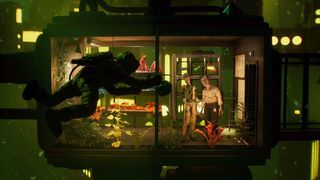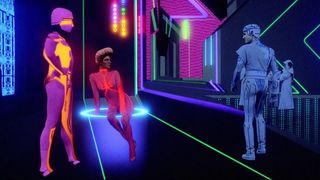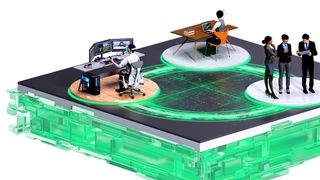2015 will be a huge year for VFX. We're getting the sequel to one of the most successful films ever in Avengers: Age of Ultron, and the latest in the saga that kickstarted effects into the mainstream – Star Wars: The Force Awakens.
So what changed in 2014, and how are these trends affecting moviemaking right now?
01. Scaling the Uncanny Valley
For a start, let's give the stalwarts of the VFX industry a round of applause for 2014, especially its two keynote films: Guardians of the Galaxy and Dawn of the Planet of the Apes. Watching these blockbusters it's easy to argue that even the Uncanny Valley hasn't quite yet been scaled, at least we're nearing the summit.
Who knew that we could fall for a talking raccoon? And while the first Apes reboot boasted some astounding work, the 'Apes in rain' of the sequel meant that we were lost in the performance.
In short, visual effects entranced audiences in 2014, whether generated primarily from motion capture as per Apes or keyframed from source as with Guardians. And that's just set the bar even higher for 2015.
02. Disappearing VFX
The improvement in render engines and the subtlety of creature model and fur work meant that the VFX disappeared into the background in 2014. Mastering is when we stop creating grand gestures and concentrate on subtleties and nuance – and with the virtual performances in these films it really does feel like WETA for Apes and MPC and Framestore for Guardians are masters in the field.
Striving for realism was also taken to the stars with Christopher Nolan's epic Interstellar. Here Double Negative used the theories of physicist of Kip Thorne to create a new render engine that could depict as accurately as is scientifically known the passage of light around a black hole:
Get the Creative Bloq Newsletter
Daily design news, reviews, how-tos and more, as picked by the editors.
03. Projections and practical sets
The striving for reality in Interstellar also extended to principal photography, from location filming in Iceland to extensive studio work for the spaceship interiors.
Instead of using greenscreen out of the spacecraft windows, the VFX crew used huge projection screens to allow the cast to see the wonders of the black hole, thus allowing the acting, lighting and directing processes to be practically based on set.
The excellent Edge of Tomorrow by Doug Lihman used practical suits for a lot of the beach scenes. And this striving for real set builds rather than greenscreen is again being seen in the development shots for the next Star Wars.
In this clip released by director JJ Abrams we see a detailed look at the full-size model of the Millennium Falcon and end up on a very familiar detail on the underside.
It is not just science fiction that's benefitting from this return to practical sets, which are augmented either while filming or in post. The new Biblical epic Exodus from Ridley Scott uses extensive practical sets with hardly any greenscreen, with digital set extensions being used where needed:
In 2015, VFX will also continue its expansion into invisible work for film as well as blockbuster TV, such as environments for the recently finished Boardwalk Empire.
We could also see an increase of CGI performances, with a CGI Paul Walker being used to finish the performance in the new Fast and Furious franchise after the actor died in an accident.
04. New tools
The tools that are used to drive VFX are undergoing a sea change too, with The Foundry increasing its compositing product range with a range of Nuke releases, including a free non-commercial version and new all-in-one Nuke Studio.
But it’s the takeover and subsequent release of Fusion from Blackmagic that has the industry paying attention with its free-for-HD version. A lot of VFX companies from freelancers to larger studios will spend a lot of 2015 evaluating their pipeline to see if these tools can add or replace their current pipeline.
05. Live action becomes the new animation
VFX is also being used to enable 'live action' versions of what would have been handled traditionally by traditonal animation. In 2014 Maleficent was a massive hit, and in 2015 the Kenneth Branagh directed Cinderella, with Cate Blanchett as the Evil Stepmother, looks to carry on with these fairytale retellings.
Personally I'm looking forward to seeing James Spader continue scaring the heroes in Avengers: Age of Ultron, the Wachowski's new Sci-fi Jupiter Acsending, which looks like combines the kinetics of Speed Racer with the scale of Star Wars.
Speaking of scale, 2015 looks like it will be a massive year, and with the digital technology finally allowing the creation of on set and post workflows to merge analogue techniques with the latest advances in technology, it seems appropriate that we get the latest installments in arguably the two most important VFX films of all time in Star Wars and Jurassic Park.
Like this? Read these!
- Discover what's next for Augmented Reality
- Download free textures: high resolution and ready to use now
- The designer's guide to special characters
Words: Mike Griggs
Mike Griggs is a freelance 3D, VFX, mograph artist and technical writer. He can be found on twitter @creativebloke, facebook/creativebloke and his work can be seen at http://www.creativebloke.com.




